2015-12-23 By Robbin Laird and Ed Timperlake
There is a growing literature on the challenges to U.S. forces facing more difficult combat conditions as competitors and adversaries enhance their capabilities.
The anti-access, area denial challenge, in particular, has been a key theme as the sea services face the future; but the Marines and the U.S. Navy as well as coalition partners are transforming their capabilities to fight and definitively win combat engagements throughout this A2AD expanded battlespace.
It is clear that the sea services recognize the challenge but are reshaping their forces to meet that challenge.
And they are doing so through training, technology, innovation, new platforms and new concepts of operations.
With visits to the advanced combat training units of the U.S. power projection services; Marine Air Weapons and Tactics Squadron (MAWTS-1) MCAS Yuma, USAF Weapons School at Nellis AFB, and Naval Strike and Air Warfare Center at NAS Fallon, all have all underscored that the services are working together to deliver combat effects over greater distance and with much greater precision lethality.
Additionally, there is a significant enhanced effort to work with coalition partners, which is a clear part of extending the reach of U.S. combat forces and for the coalition partners as well.
We had a chance recently to discuss the way ahead with regard to enhancing the capability of the sea services and their joint and coalition role in fighting in the expanded battlespace with the head of Air Warfare in the Navy, Rear Admiral Manazir.
The discussion with Manazir was much wider than simply a discussion of how the carrier air wing, and the new carrier was evolving; it was about how the sea services overall were being transformed by the ability to work more effectively with joint and coalition forces.
The focus was on the impact of new platform and technologies but in an interactive relationship with the fleet operating today; transformation is about innovation allowing shaping a new way forward without throwing away combat proven core capabilities, which are capable of modernization.
In 21st Century training terms, this is being shaped and practiced as the U.S. and its allies are building Live Virtual Constructive Training (LVCT) facilities, which can allow for training against adversaries over much greater distances than is possible by simply flying on single service training facilities.
For example, when visiting Richmond Air Base this summer in Australia, we witnessed the Royal Australian Air Force preparing for and then completing its LVCT with the USAF and the Canadian Air Force by means of audio and visual links directly from Richmond to Nellis.
This was one of the first in a growing capability to extend the reach of common training and fighting capabilities via LVCT.
You train as you fight; and you fight as you train.
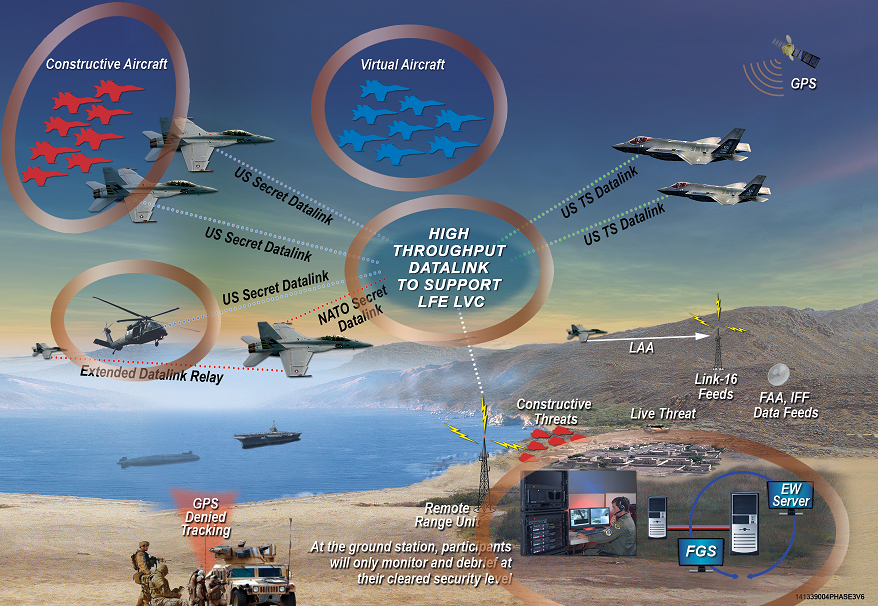
When visiting Fallon, we discovered that the U.S. Navy had taken this effort a step further than before.
Through global communications, a Carrier Strike Group in combat could reach back to instructors at NSAWC to improve combat tactics almost real time.
Concurrently, during the Fallon work-up the air wing preparing to go to the next carrier deployment was working directly with real time lessons to carry forward the tradition of the hallmark of Naval/Marine aviators to be “ready on arrival.”
According to Rear Admiral Manazir: “LVCT will enable us to train in a more robust environment than we are on our current ranges that are geographically constrained, and currently do not have the full high end threat replicated.
LVCT will allow us to train to the full capabilities of our platforms across a variety of security environments and do so without exposing our training process to an interested adversary.”
For Admiral Manazir, the new ships coming online are clearly part of the equation involved in the transformation necessary for the sea services to operate and prevail in the 21st century battlespace.
The integration of the various platforms operating in the surface and subsurface fleet are evolving in a more integrated and interactive manner, which can allow presence assets to reachback to the fleet or to the joint or coalition forces to deliver escalating combat effects, as needed.
Notably, the evolving capabilities of the amphibious fleet provided a significant boost to the capabilities of the sea services.
Rather than simply providing transportation for forces to get into the area of interest, the amphibious fleet, becoming more of a task force, than being a narrowly understood Amphibious Ready Group, provides a powerful persistent presence asset which can deal with a much wider range of tasks and with the new aircraft onboard much greater capability to reach back to the rest of the forces provided by the sea services.
“The Marine Corps has grown in capability from being naval infantry to now having the capability to come from the sea with high-end meshed, networked, honeycombed, resilient capability, with an array of options depending on how you integrate the force.
The sea base itself has a powerful ability strategically to wage war because you don’t need a permission slip from a foreign power to use their bases.
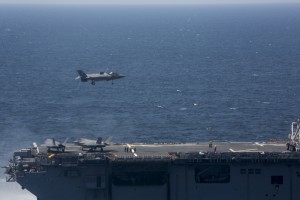
The United Stated Navy and the United States Marine Corps singly in the world have retained and modernized the sized capability that allows one to fight a nation with our force rather than just fight another naval force.”
Rear Admiral Manazir talked about the new large deck carrier, the USS Ford, in terms of its contribution to the expanded battlespace, and not so much the epicenter of a classic carrier strike group.
He focused on the new ships – the USS America, the USS Ford and the Queen Elizabeth – as providing foundations for 21st century operations.
“The USS Ford is a 21st century naval infrastructure asset, which lives off and further enables the transformation of the air wing.
It’s a facilitator for all the things you’re going to do off the flight deck.
The electrical generation capacity on the Ford is three times what the Nimitz’s is.
It gives you the ability to put greater electronic systems on to the ship.
The ability to have high power requirements with high cooling requirements for your data servers is enabled by the ship.
It has the capacity to be able to support those things and in conjunction with the high-end air wing we’re building, you’re going to be able to do the missions we discussed earlier more effectively in the expanded battlespace.
The Ford’s infrastructure will be partnered with the airplanes that come on and off the flight deck.”
In understanding the evolution of the air wing aboard the sea services decks, the F-35 is a crucial element, but it is about accelerating what those services have been building towards for some time, namely the capability to operate force packages across an integrated battlespace.
For sure, the F-35 with its ability to push data across the F-35 coalition, as well as to push data back to the ships is an asset for transformation, but this transformation is itself part of fundamental change in the way the sea services are and will fight in the extended battlespace.
Rear Admiral Manazir views the F-35 as a key information force multiplier.
“We are doing what Bayesian theory talks about, namely we are providing more and more information to get closer to the truth in targeting or combat situation.
One can reduce that fog of war by increased understanding of what actual truth is, you’re going to have better effects.
This is why the technology that the F-35 brings to the fight is so crucial. You have decision-makers in the cockpit managing all of this information.
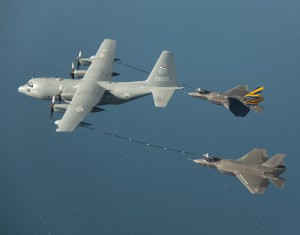
With Block 3F software in the airplane, we will have data fusion where you transform data information to knowledge enabling greater wisdom about the combat situation.
The processing machines in the F-35 provide enough of the fusion so that the pilot can now add his piece to the effort.
This enables the ships to enhance their ability to operate in the networks and to engage with the air fleet in dynamic targeting at much greater distance.
It is about reach not range for the honeycomb enabled expeditionary strike group.
The F-35 is a key enabler of this shift, but it is part of an overall effort to operate in the expanded battlespace.”
In other words, the sea services are expanding their reach, remote sensing and precision strike capabilities in the expanded battlespace.
The sea services can operate in wider areas of combat by being networked into an operational honeycomb of forces with reach, range and lethality.
They are shaping a force capable of operating effectively in discrete but interactive and interconnected force packages.
And they can operate in the domains of air, sea, and space and against land based targets.
This 21st Century technology dynamic makes the synergistic reach of the force much greater than the range of any specific assets operating off of the surface of ship or operating from an airfield.
An F-35 enabled force facilitates reach not range of the entire engagement force.
It is not simply about the forces organically operating of the Ford, or the America or the Queen Elizabeth; it is about their ability to reach into the joint or coalition honeycombed operating force.
Specifically with regard to the large deck carrier, and the USS Ford in particular, Manazir highlighted the synergy between the evolution of the air wing and of the evolution of capabilities built into the ship. He described a shift from thinking about the carrier as the deck which can fly X number of aircraft to thinking of the carrier as a moving epicenter of an extended strike enterprise, that can work with the USAF and coalition partners and live off of their combat capabilities in the expanded battlespace.
“The focus is upon the carrier as a moving epicenter for a netted capability with the joint and coalition force.
It is not about counting the number of airplanes on the deck or projecting the future existence of paper airplanes.
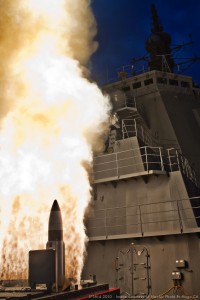
It is about the air wing we are building and how it will operate with the transformed joint and coalition forces we are collectively modernizing.
The approach is to have force structure flexibility with an interconnected extended battlespace.
You can operate as a separate force package; or as a federated force when you are connected but can plug and unplug; you can be interoperable, integrated or interdependent; depending on time, circumstances and mission.
What the Ford class, the Joint Strike Fighter and future unmanned platforms bring is the ability to pull the information in and be an epicenter of an enlarged and extended reach for the joint and coalition force.”
In short, the decade ahead is not a repeat of the past 15 years; it is not about a continuation of the land-centric and counter-insurgency (COIN) slow motion way to fight a war.
It is about the American military standing in parity partnership with allies to demonstrate global agility.
The technology and training ranges exist to develop the con-ops to insert force to achieve discrete and defined objectives, to maneuver in the extended battlespace, to work with allies and joint forces to credibly prevail across the full range of military conflict in any part of the globe.
For the power projection forces –USN/ USMC, USAF with appropriate elements of the US Army, especially Air Defense Artillery – it is about the capability to work across an extended battlespace with flexible means which can be linked together as necessary to prevail in the military and strategic conditions facing the US and its allies in the period ahead.
The capability to go after fleeting targets is enhanced as the sea services shift towards a fifth generation warfare enabled force.
As Rear Admiral Manazir puts the transition:
“With the fifth generation aircraft and their sensors and fused data you can cover a much greater swath of combat space than with legacy aircraft.
And as we sort through how to integrate unmanned systems with F-35s we will be able in a single operational unit cover significant combat space.
You are looking at exponential growth in coverage capabilities to inform the process of generating the combat effects, which you want in that extended battlespace.
And the growth in the ability to generate better target information will allow us to execute strikes within our rules of engagement.
The coming of the F-35 will help in this process.
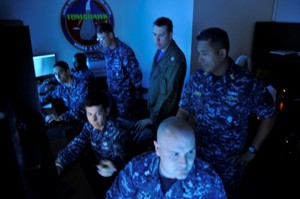
We train our aviators in the Navy and the Marine Corps to be decision-makers, given the constraints.
A lot of times, we can’t apply the rules of engagement we’ve been given because we can’t identify that’s a bad guy, whether he’s on the ground or in the air.
With better fidelity of information at the forward edge of the battle, I can execute more rapidly as well.”
It is about building capabilities at the high end, which have the flexibility to operate through the range of military operations or ROMO.
It is about powerful and flexible force packages which can operate and dominate in specific military situations but be linked to other capabilities to provide the kind of reachback and dominance which effective deterrence requires.”
This future is now, the technology, training and tactics is a never ending work in progress but within reach with sufficient resources.
It is up to the Congress to continue to fund this next chapter in the American way of war.
Editor’s Note: In our interview with Rear Adm. Thebaud, the CO of the 2nd Expeditionary Strike Group, the Admiral highlighted the impact of the evolving capabilities of the amphibious fleet was highlighted:
“We already have 80% of the ships and other major equipment we’ll have 20 years from now.
The key is to evolve its capability and to draw upon the new systems to shape a more effective combat force,” she said.
The evolution of amphibious capabilities will allow the rest of the surface fleet, and the aircraft carriers to evolve as well.
An earlier version of this article was published by Breaking Defense.

